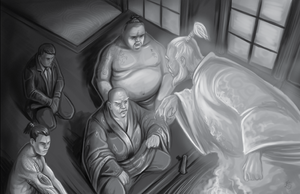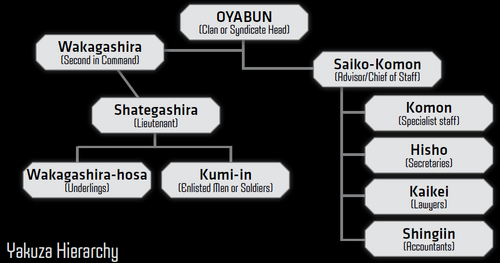
Yakuza (やくざ or ヤクザ) also known as gokudou, are members of traditional organized crime groups that originate from Japan. In Japanese legal terminology, yakuza organizations are referred to as boryokudan (暴力団, "violence groups"), which more traditional "samurai heritage" Yakuza members consider an insult as boroyokudan is applied to any violent criminal.
Unlike many organized crime groups, like the Triads and the Mafia, which evolved from secret societies, the model of the Yakuza was the machi yakko (町奴, "town servant"), vigilantes protectors within the community (Although many citizens also view them as kabukimono or crazy ones, for their propensity toward violence, vulgar slang, and bizarre appearance) or the masterless samurai ronin. As a result, at least in the JIS and it's protectorates, Yakuza groups maintain open offices, often with a wooden plank on the front door displaying the group name and their emblem. Yakuza members often wear sunglasses and flashy suits so that their profession can be immediately recognized by civilians (堅気, katagi). Members typically wear insignia pins on their suits, and, if needed, can display their tattoos or customized cyberware.
Organization
The Yakuza group are typically headed by the Oyabun (親分, "father" or "boss") or Kumicho (組長, "family head"), who issues orders to his subordinates, the kobun (子分, "children"). This is a variation of the traditional Japanese social heirarchal structure of senpai-kohai (Senior-Junior). There are some exceptions to this, such as the Inagawa-kai, which operates with multiple kumicho, all of which share equal power within the organization.
A Yakuza members connection within the organization is based off the place in the order of the sakazuki (盃, "sake sharing") ritual. The sakazuki ritual is sharing the sake from a single cup with another, and comes from the traditional practice of a Shinto wedding. Kumicho are the top of the organization, and control saiko-komon (最高顧問, "senior advisors"). The saiko-komon are responsible for their own turf in different cities or regions, and have their own underlings, like underbosses, advisors, accountants, and enforcers. Those who receive sake directly from the kumicho are consider the "immediate family" and are ranked in term of elder or younger brothers. However, each kobun, in turn, can offer sakazuki as if they where the kumicho to his underlings to form an affiliated organization, which might in turn form lower rank organizations.
Yakuza refer to each other as if they where family members, such as fathers, elder and younger brothers. However, contray to Western belief, blood relation is not necessary for membership into the Yakuza, as it is with the Mafia, and the Yakuza accept non-Japanese members, such as Korean-Japanese, into their ranks. Many Yakuza members cut all family ties upon joining the organization and immediately transfer loyalty to the kumicho. The Yakuza group replaces the family in the lives of its members.
Most Yakuza organizations are usually referred to using the number of generations or times the oyabun or kumicho has been replaced, either through retirement or death, as a measure of the age of that group. For example, in 1984, the 4th Yamaguchi-gumi was formed when Takenaka Masahisa became the new oyabun following a bloody succession from the 3rd Yamaguchi-gumi, headed by Taoka Kazuo. Takenaka was killed in 1985, and in 1989, the 5th Yamaguchi-gumi was formed when Watanabe Yoshinori took control as the organization's fifth oyabun.

Occupational Background of Yakuza
| Occupation | Full status members | Marginal status members | Total |
| Bakuto (Gamblers) | 26,960 | 5,148 | 32,198 (31%) |
| Tekiga (Peddlers) | 21,438 | 2,570 | 24,008 (23%) |
| Gurentai (Hoodlums) | 9,861 | 1,639 | 11,500 (11%) |
| Seaport racketeers | 3,221 | 0 | 3,221 (3%) |
| Sokaya (Corporate Racketeers) | 47 | 2,417 | 2,464 (2%) |
| Scandal sheet extortionists | 41 | 803 | 844 (1%) |
| Prostitution gangers | 495 | 74 | 569 (1%) |
| Others | 39 | 29,202 | 29,241 (28%) |
| Totals | 62,102 | 41,853 | 103,955 (100%) |
Source: National Police Agency, 1980
Note: These categories are fluid; there are frequent crossovers. For example, many bakuto and tekaya may act a sokaya and other racketeers. Also many sokaya and right wing gangers are not counted as Yakuza in official statistics and do not appear here. The total number of yakuza officially stood at 98,771 in 1984.
Notes from David E. Kaplan & Alec Dubro's "Yakuza - The explosive account of Japan's criminal underworld", Queen Anne press, 1987.
Yakuza in the Sixth World
The Yakuza have linked their fortunes to Mitsuhama Computer Technologies. The MCT uses the Yakuza on the streets to advance their interests and the Yakuza in turn use MCT to launder their money. Being extricably tied together has greatly benefited both, though some Yakuza rengos are violently opposed to those who have such ties. Their association with MCT has given the Yakuza a ruthless efficiency.[1]
Activities in the Sixth World
Yakuza in the late 21st century are involved in a wide variety of activities. Their main sources of income are gambling, drug trafficking, prostitution, and corporate extortion.[2][3] Other activities include protection rackets, street sales of drugs, BTL chip production and trafficking, manufacturing of counterfeit goods, loansharking, organ-legging, and Matrix crimes.[4][5]
Though there are many Yakuza syndicates, three of them are major international crime syndicates. The largest and most powerful Yakuza group is the Watada-rengo, which is a worldwide organization with branches in Southeast Asia, the UCAS, and Amazonia. The Four Oyaban Rengo is likewise a worldwide syndicate, through its control of the Mitsuhama Computer Technologies megacorporation. Shotozomi-rengo which is Watada-rengo's main rival, has branches in both North and South America.[6]
Membership in the Sixth World
In the aftermath of the Awakening, the Yakuza discriminated against metahumans. Yakuza members who had changed, either committed suicide or went into exile. In the following decades, the Yakuza syndicates forbid the recruitment of women, metahumans, foreigners, or magic users.[7] Eventually a divide emerged in the Yakuza between the Old School and the New Way factions. The traditionalists of the Old School believed in Japanese superiority and were xenophobic ultra-nationalists. In turn the reformers of the New Way embraced and accepted the Awakened, metahumans, women, and those whom are part-Japanese.[6]
The Watada-rengo are fully Old School, as every member syndicate is required to follow that path when it comes to membership. Their main rivals, the Shotozumi-rengo has left it to its members to decide what policy to follow, therefore some syndicates are Old School and others are New Way.[8] Four Oyabun Rengo has taken a firmly neutral position when it comes to the ideological dispute.[9] The newly established and growing Wanibuchi-rengo of Neo-Tokyo is solidly New Way, and has been recruiting extensively from the formerly proscribed classes of people.[10]
Shadowrunners
The Yakuza don't like shadowrunners, as they see them as dishonorable. Unless the team is all Japanese, human, and male, they will often have issues with at least one member of the team. Yakuza "Johnsons" assume the shadowrunners are idiots, often refuse to answer questions or provide more information, and prefer to pay in kind (usually vices, though sometimes equipment).[11]
Nations and City-States with Yakuza
Far East:
- Japan, Korea,[12] Henan,[13] Philippines,[14] Vietnam,[15] Thailand,[16] Burma,[16] Shan State,[17] Pattani,[17] Javanese Republic,[18]
North America:
- United Canadian and American States,[6] California Free State,[19] Aztlan,[6] Tsimshian Nation,[20] Algonkian-Manitou Council,[21]
Europe:
Rest of the World:
Major Boryokudan
- Four Oyabun Rengo
- Honjowara-gumi
- Ichiwa-kai
- Inagawa-kai
- Karatsa-gumi
- Kawaru-gumi
- Kenran-kai
- Kinsei-kai
- Kodachi-gumi
- Korogai-gumi
- Mita-gumi
- Naheka-rengo
- Nishidon-gumi (defunct)
- Saiki-rengo (defunct)
- Shigeda-gumi
- Shotozumi-gumi
- Shotozumi-rengo
- Sumiyoshi-kai
- Wanibuchi-rengo
- Watada-rengo
- Yamaguchi-gumi
Other Yakuza Groups
References
Article forked from "Yakuza" on Wikipedia
- ↑ Shadowrun Fifth Edition Core Rulebook p.34
- ↑ Underworld Sourcebook p.40
- ↑ Underworld Sourcebook p.45-46
- ↑ Corporate Enclaves p.98
- ↑ Corporate Enclaves p.100-103
- ↑ 6.0 6.1 6.2 6.3 Vice p.52
- ↑ Underworld Sourcebook p.39
- ↑ Vice p.53
- ↑ Vice p.54
- ↑ Corporate Enclaves p.101-103
- ↑ Run Faster p.208
- ↑ Shadows of Asia p.187
- ↑ Shadows of Asia p.43
- ↑ Shadows of Asia p.172
- ↑ Shadows of Asia p.148
- ↑ 16.0 16.1 Shadows of Asia p.149
- ↑ 17.0 17.1 Shadows of Asia p.154
- ↑ Shadows of Asia p.159
- ↑ Shadows in Focus: City by Shadow: San Francisco p.15
- ↑ Shadows of North America p.163
- ↑ Shadows of North America p.27-28
- ↑ 22.0 22.1 Shadows of Europe p.36
- ↑ Shadows of Europe p.172
- ↑ Shadows of Europe p.196
- ↑ Shadows of Europe p.57
- ↑ Runner Havens p.127
- ↑ Shadows in Focus: City by Shadow: Metropole p.27
- ↑ Shadows of Asia p.196
- ↑ Target: Awakened Lands p.27
Index
- Mob War!
- New Seattle
- Runner Havens
- Seattle Sourcebook
- Shadows of Asia, 43, 148-149, 154, 159, 172, 187, 196
- Target: Smuggler Havens, 54
- Target: Wastelands, 73
- Underworld Sourcebook, 39-40, 45-46
- Vice, 46-64
- Corporate Enclaves, 98, 100-103
- Shadows of North America, 163
- Target: Awakened Lands, 27
- Aztlan, 166
- Shadows of Europe, 36, 57, 172, 196
- Run Faster, 208
- Shadowrun Fifth Edition Core Rulebook, 34
